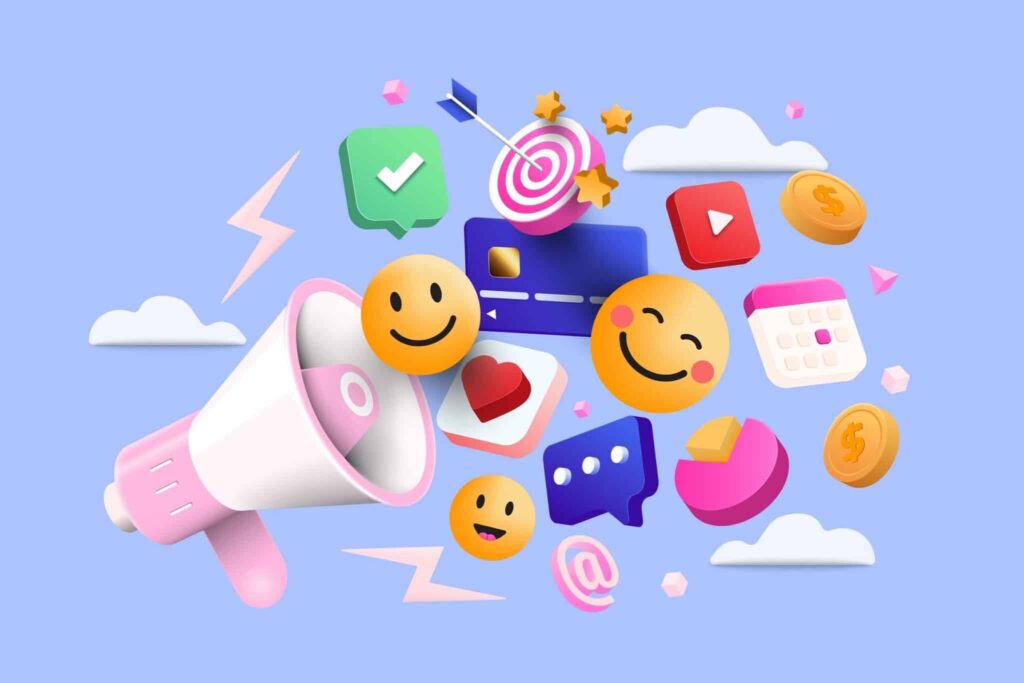Introduction
In today’s fast-paced digital world, small businesses are under increasing pressure to compete with larger, more resource-rich companies. Fortunately, social media has emerged as one of the most accessible and powerful marketing channels available to businesses of all sizes. As we step deeper into 2025, social media marketing is no longer a luxury—it’s a necessity. Whether you’re a startup looking to build brand awareness or an established business aiming to scale faster, leveraging social media platforms like Instagram, Facebook, TikTok, and LinkedIn can dramatically accelerate your growth. This blog explores how social media marketing helps small businesses grow faster, using data-driven insights, real-life examples, and the latest trends that make 2025 a pivotal year for digital marketing.
How Social Media Marketing Drives Fast Growth for Local Small Businesses in 2025
Social media marketing has become an essential growth engine for small and local businesses in 2025. With more than 4.95 billion active users worldwide, platforms like Instagram, Facebook, and TikTok offer unprecedented access to a massive audience. Unlike traditional advertising, social media allows for micro-targeting based on location, interests, behaviors, and even life events—making it incredibly effective for local outreach.
For small businesses, visibility is everything. Social media ensures your brand appears where your audience spends their time—on their phones. Businesses can now target ads directly to users within a specific zip code or city radius, ensuring that promotional content reaches nearby customers. Local hashtags, geotags, and location-based ads all enhance discoverability and engagement, giving small businesses a strategic edge over competitors who rely on outdated marketing methods.
Moreover, real-time interaction with followers through comments, direct messages, and live videos allows businesses to build trust and community. This engagement translates into faster brand recognition, higher customer loyalty, and increased foot traffic or online conversions. The shift towards mobile-first marketing in 2025 further cements social media’s role in helping local businesses scale with precision and speed.
The ROI of Social Media for Small Business Owners: Worth the Investment?
Many small business owners often question the return on investment (ROI) of social media marketing. In 2025, the numbers speak for themselves. According to a recent review by HubSpot, businesses that actively use social media generate 78% more inbound leads compared to those that don’t. Additionally, platforms like Facebook and Instagram offer detailed analytics that help track impressions, clicks, conversions, and customer behavior—making it easier than ever to measure ROI accurately.
One major advantage of social media marketing is its scalability. Small businesses can start with minimal budgets and gradually increase their investment based on performance. For instance, Facebook Ads allow you to start with as little as $5 per day while reaching thousands of targeted users. Unlike traditional media where spending is rigid, social media campaigns can be optimized in real-time, ensuring every dollar is spent efficiently.
Even organically, the ROI is significant. Posting consistently with relevant content boosts brand visibility and helps build a loyal audience base. Engagement metrics like likes, shares, comments, and saves contribute to higher reach and credibility. Over time, these interactions compound, driving more website traffic, inquiries, and sales—ultimately yielding a strong ROI for the small business owner.
Instagram & TikTok Marketing Strategies That Help Small Businesses Go Viral
In 2025, Instagram and TikTok are leading the charge in helping small businesses go viral. Both platforms are visual, mobile-centric, and built for engagement. They offer features like Reels, Stories, and Live Video—tools that small businesses can use to create captivating content and reach thousands organically.
The secret to virality on these platforms lies in trends and storytelling. Small businesses that tap into trending audio, challenges, or formats while weaving in their brand message are more likely to be picked up by the algorithm. A bakery in Texas recently went viral with a 15-second Reel showing behind-the-scenes cake decorating using trending audio. That one post led to a 400% spike in online orders and over 10,000 new followers in a week.
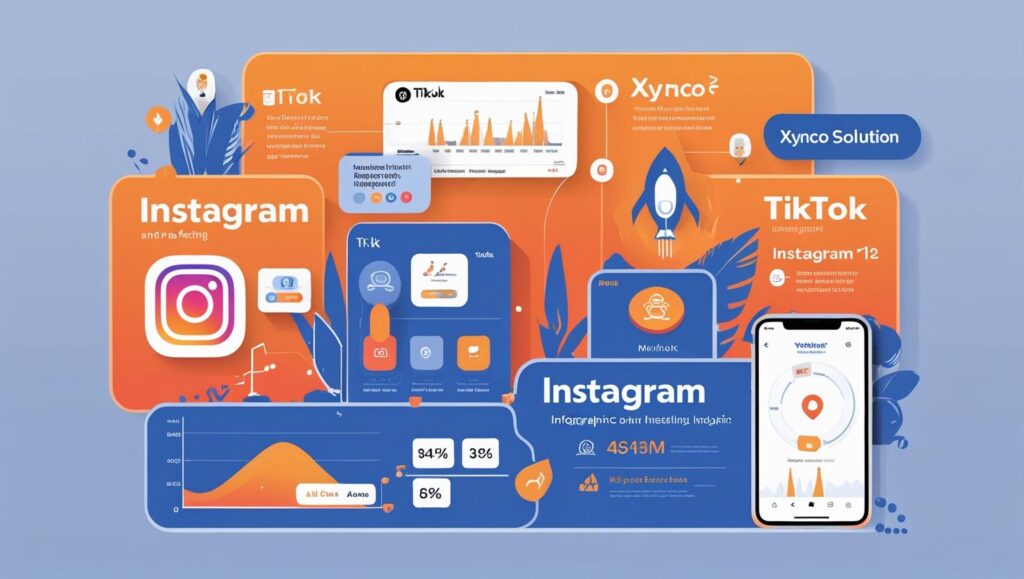
TikTok, in particular, is known for leveling the playing field. Unlike Instagram, where follower count plays a bigger role, TikTok’s algorithm favors content quality and engagement. Even a brand-new account can go viral if the content resonates. Hashtags, duets, stitch features, and engaging hooks within the first 3 seconds are key strategies for success.
Consistent posting, interacting with your audience, and using clear calls to action can significantly increase reach and conversion. If used smartly, Instagram and TikTok can turn a local brand into a global name in a matter of days.
How Consistent Social Media Posting Builds Brand Trust for Startups
Startups often struggle with gaining trust from new customers. Consistent posting on social media is one of the most effective ways to establish credibility and build a trustworthy brand image. In 2025, users evaluate your brand based on how active and consistent your online presence is. A dormant Instagram or a Facebook page without recent posts sends a negative signal to potential customers.
By posting regularly—whether it’s educational content, customer testimonials, behind-the-scenes footage, or product updates—startups create a sense of reliability. It tells your audience that you’re active, invested, and serious about your business. A study by Sprout Social shows that businesses that post consistently see 3.5x higher engagement than those that post irregularly.
Consistency also helps train platform algorithms to push your content more often. When users interact with your posts, the platform takes it as a positive signal, increasing your visibility in feeds and explore pages. The more you’re seen, the more people remember you—and that memory builds familiarity and eventually trust.
Facebook Ads for Small Business: Budget-Friendly Growth in 2025
Facebook Ads continue to be one of the most cost-effective advertising solutions for small businesses in 2025. With more than 2.9 billion active users, Facebook offers granular targeting options that allow businesses to reach specific age groups, locations, interests, and even buying behaviors. Whether you’re promoting a local restaurant, e-commerce store, or service-based business, Facebook Ads can be tailored to suit your exact goals.
One of the biggest advantages for small businesses is Facebook’s budget flexibility. You can set daily or lifetime budgets based on your comfort, with no minimum requirement. Moreover, with features like A/B testing, dynamic creatives, and conversion tracking, even a novice marketer can optimize campaigns for better results over time.
A local spa in Manchester reportedly increased bookings by 68% in just two months using Facebook Ads targeted at women aged 25–45 within a 10-mile radius. They used compelling visuals, limited-time offers, and retargeted users who had visited their site but hadn’t booked.
Facebook Ads also integrate seamlessly with Instagram, allowing businesses to run cross-platform campaigns from a single dashboard. In 2025, this level of control and affordability makes Facebook Ads a no-brainer for growth-focused small businesses.
Why Small Businesses Can’t Afford to Ignore Social Media in Today’s Market
In 2025, the digital marketplace is more competitive than ever before, and social media is no longer optional—it’s essential. Small businesses that ignore social media are essentially turning a blind eye to one of the most powerful and cost-effective growth tools available today. According to a recent review by Oberlo, over 71% of small-to-medium businesses now use social media to market themselves—and those that don’t risk falling behind.
Social media platforms allow brands to communicate directly with their customers, respond to inquiries in real-time, handle complaints, and promote products—all from a single dashboard. This direct interaction builds customer loyalty, promotes transparency, and increases brand visibility. Furthermore, when your competitors are already leveraging these platforms, staying absent creates a gap in your market presence that someone else will quickly fill.
The modern consumer expects your business to be present and active on social platforms. From checking reviews to seeing product images and customer interactions, potential buyers often use social media as a credibility check before making purchasing decisions. Without an active presence, your business may appear outdated or even untrustworthy. In a digital-first world, social media marketing is not just a strategy—it’s a survival tactic.
10 Social Media Tools Every Small Business Should Use to Save Time & Money
With limited budgets and teams, small businesses need tools that streamline their social media efforts without sacrificing quality. Thankfully, 2025 offers a wide array of tools designed to save time, increase efficiency, and maximize results. Here are ten tools every small business should consider:
-
Canva – Design tool for creating stunning graphics, stories, and reels without a designer.
-
Buffer – Schedule posts across multiple platforms and get performance insights.
-
Later – Ideal for Instagram scheduling with drag-and-drop content calendar.
-
Hootsuite – Complete social media management, from publishing to monitoring.
-
CapCut – Edit short-form videos quickly for TikTok, Reels, and YouTube Shorts.
-
Metricool – A great all-in-one tool for analytics, planning, and content strategy.
-
Copy.ai – Generate captions and post ideas using AI.
-
Linktree – Manage multiple links in your bio effectively.
-
Google Trends – Understand what’s trending in your niche and align content accordingly.
-
Mailchimp – For integrating email marketing with your social media funnel.
Using the right tools allows small businesses to automate repetitive tasks, maintain consistency, and compete with larger brands more effectively. In 2025, digital efficiency is the key to growth.
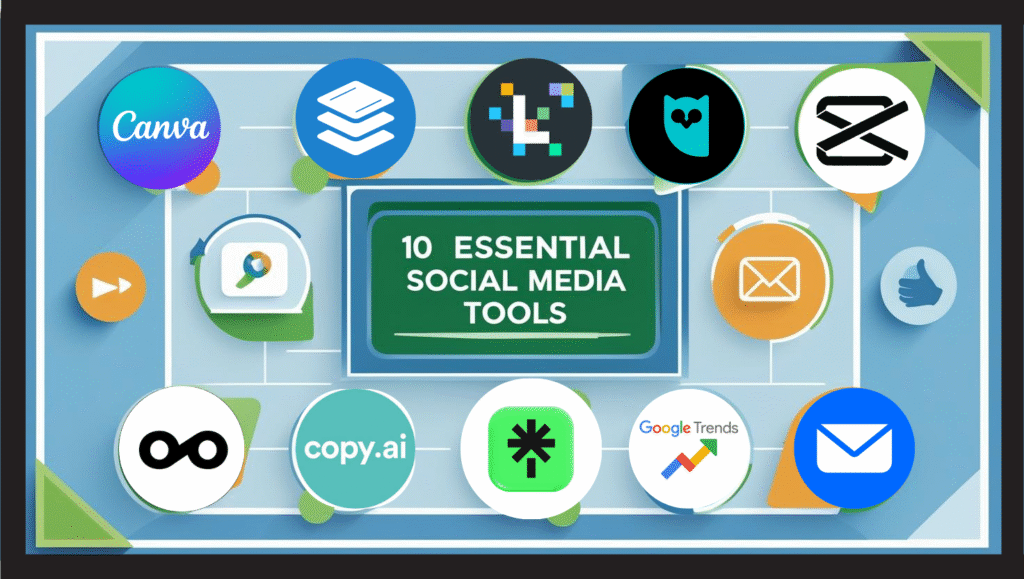
Organic vs. Paid Social Media for Small Businesses: Which Works Best?
When considering social media strategies, small business owners often wonder whether to invest in organic growth or go straight into paid advertising. The truth is, both methods have their strengths—and combining them yields the best results.
Organic social media involves growing your presence naturally by posting content, engaging with followers, and building a loyal community over time. It’s cost-effective and great for establishing brand voice, trust, and long-term relationships. Businesses that consistently post high-quality content and interact with followers see better engagement, loyalty, and word-of-mouth promotion.
Paid social media, on the other hand, offers immediate results. With platforms like Facebook, Instagram, and TikTok Ads, businesses can target very specific audiences based on location, age, interests, and behavior. Paid strategies are essential for lead generation, promotions, or product launches where time-sensitive reach is important.
In 2025, the line between organic and paid is blurred. Platforms reward organic content that performs well by offering better ad delivery when boosted. The smartest approach for small businesses is to build a strong organic presence and amplify the best-performing content with paid campaigns for maximum impact.
Success Stories: How Small Businesses Grew 10x Using Only Social Media
Many small businesses have turned into household names using only social media marketing, proving that smart strategy can beat big budgets. Take the case of Mo’s Bakeshop, a home-based bakery in Leeds. Mo started with a simple Instagram page in early 2023. By posting behind-the-scenes videos, running polls, and engaging with local followers, her page grew to 45,000 followers by mid-2024. She didn’t spend a penny on ads but built trust through authentic content and customer interaction. Today, she gets 80% of her orders via Instagram DMs.
Similarly, a pet grooming salon in Birmingham used TikTok to showcase grooming transformations using trending audio and hashtags. Their videos went viral, reaching over 1 million views. As a result, their bookings tripled within weeks, and they now operate on a waitlist basis.
These stories highlight that with creativity, consistency, and understanding your audience, small businesses can grow 10x faster—even without massive ad budgets. In 2025, social media has the potential to be your main growth driver if used correctly.
Social Proof & Reviews: How Social Media Builds Trust in Small Brands
In an age where consumers trust user-generated content more than traditional ads, social proof is gold. Social media provides the perfect platform for small businesses to showcase reviews, testimonials, and customer interactions. Seeing real people talk positively about your brand influences potential customers and builds instant credibility.
Reviews on platforms like Facebook, video testimonials in Instagram Stories, and user-generated content (UGC) shared on your business profile are all forms of social proof that increase trust. Highlighting customer shoutouts, tagging satisfied clients, and reposting their experiences create a community around your brand and humanize your marketing.
In 2025, buyers don’t just want to know that your product is good—they want to see that other people like them have used it and found value. By strategically using social proof, small businesses can convert skeptics into buyers and one-time buyers into loyal fans.
The Power of Reels & Short Videos in Growing Small Local Brands
Short-form video content continues to dominate in 2025. Instagram Reels, TikToks, and YouTube Shorts are the fastest-growing content formats, making them essential for any small business marketing strategy. These bite-sized videos are quick to produce, easy to consume, and more likely to go viral compared to static images or long-form posts.
Short videos work exceptionally well for local brands looking to showcase their personality, process, or products. A hair salon posting a 15-second “before & after” transformation, or a local cafe showing how they make their signature coffee drink—these are the types of videos that grab attention and encourage shares.
Algorithms also prioritize video content, meaning your reach and engagement increase significantly. A consistent short video strategy can drastically improve your visibility and lead generation. For small businesses on tight budgets, Reels and Shorts are free tools with limitless potential for exposure.
How AI is Changing Social Media Marketing for Small Businesses in 2025
Artificial Intelligence (AI) has revolutionized how small businesses approach social media marketing. In 2025, AI tools help create content, analyze performance, schedule posts, and even respond to customer inquiries. This shift has made social media more accessible and manageable for small teams.
Tools like ChatGPT (yes, like me!), Canva AI, and Copy.ai allow small business owners to generate engaging captions, image content, and even full marketing campaigns within minutes. AI-driven analytics platforms predict the best times to post, suggest high-performing hashtags, and analyze audience behavior for better targeting.
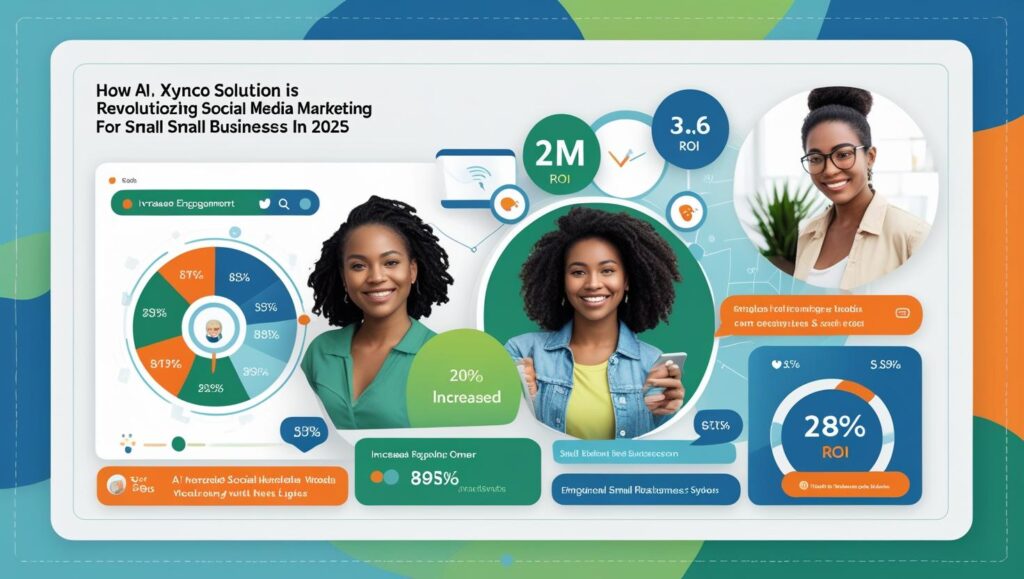
AI also powers chatbots that can automatically handle DMs, resolve customer queries, and guide users to products or services. This allows small businesses to offer 24/7 customer service without hiring extra staff.
AI is leveling the playing field, allowing small businesses to compete with big brands by automating time-consuming tasks, improving targeting, and enhancing content quality. Embracing AI in your social media workflow is no longer optional—it’s the new standard in 2025.
Social Media Content Calendars: The Secret Weapon for Consistent Growth
One of the most underrated strategies in small business marketing is using a social media content calendar. In 2025, consistency is key, and having a well-structured calendar ensures your brand stays active, relevant, and top-of-mind for your audience. It’s not about posting randomly—it’s about strategic timing, aligned messaging, and efficient planning.
A content calendar helps small businesses plan their posts weeks or even months in advance. This means you can balance promotional posts, educational content, user engagement, seasonal themes, and trending topics without scrambling at the last minute. With tools like Buffer, Later, or Hootsuite, you can schedule your content, optimize posting times, and automate publishing across all platforms.
Calendars also allow for better campaign tracking and theme consistency. For example, a small clothing boutique might plan out an entire “Spring Style Week” on Instagram with outfit tips, customer photos, and behind-the-scenes reels. That kind of consistent messaging reinforces the brand and builds engagement over time.
Most importantly, a content calendar saves time—a precious commodity for small business owners. By dedicating just a few hours a week to content planning, you ensure weeks of streamlined, engaging, and consistent brand messaging that contributes to sustained growth.
How to Generate Leads for Your Small Business Through Social Media Funnels
Generating leads from social media isn’t about luck—it’s about strategy. In 2025, small businesses are using social media sales funnels more than ever to attract, nurture, and convert followers into paying customers. These funnels are structured paths that guide users from awareness to decision using targeted content and calls to action.
Here’s how it works: First, you capture attention with engaging content—this could be a viral video, educational carousel, or entertaining reel. Next, you guide them toward your lead magnet, such as a free PDF, discount code, or consultation, often delivered through a landing page. Once they’ve opted in, you nurture the relationship through retargeting ads, email sequences, or DM engagement.
Instagram and Facebook both allow you to set up funnels using clickable stories, lead ads, and retargeting pixels. Even TikTok offers lead-gen forms and direct messaging options that integrate with CRMs. Tools like ManyChat and Mailchimp can automate this process, making it easier for small business owners to manage leads without heavy lifting.
Funnels allow you to qualify and convert leads at scale while maintaining a personal connection—critical for small business trust-building. With the right funnel strategy, social media becomes not just a branding tool, but a revenue engine.
Top Mistakes Small Businesses Make on Social Media (And How to Fix Them)
Even with the best intentions, many small businesses sabotage their growth by making avoidable mistakes on social media. The good news? These mistakes are easy to fix once you identify them.
1. Inconsistent Posting – Many businesses go silent for weeks, then flood the feed. This confuses both followers and algorithms.
Fix: Use a content calendar and scheduling tool to stay consistent.
2. Lack of Engagement – Posting and ghosting is a major red flag. Not replying to comments or DMs makes your brand feel cold.
Fix: Set aside 15–20 mins daily for engagement and conversation.
3. Ignoring Video Content – Video is dominating every platform. Ignoring it means lower reach.
Fix: Start with simple Reels or TikToks using your phone. Authentic > Perfect.
4. Selling Too Much, Too Soon – Constant sales posts turn followers away.
Fix: Follow the 80/20 rule—80% value, 20% promotion.
5. Not Using Analytics – Flying blind is risky. If you don’t measure, you can’t improve.
Fix: Review insights weekly to see what’s working.
6. Not Defining a Target Audience – Trying to appeal to everyone means appealing to no one.
Fix: Define your ideal customer and speak directly to their needs.
By avoiding these pitfalls, small businesses can use social media more strategically and grow faster without wasting time or resources.
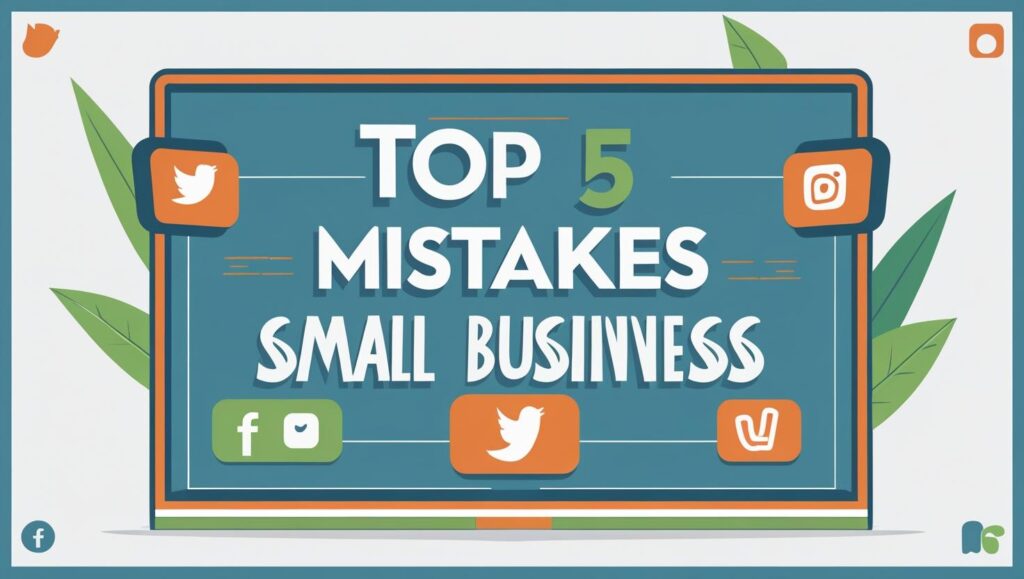
How User-Generated Content (UGC) Supercharges Small Business Growth
User-Generated Content (UGC) has emerged as a powerful force in social media marketing for small businesses. In 2025, consumers trust real people over polished ads. That’s why UGC—photos, videos, testimonials, or reviews shared by your actual customers—can drastically boost credibility, engagement, and conversions. When a customer tags your product or service in their post, they create organic word-of-mouth advertising that spreads trust instantly.
Small businesses can encourage UGC by running hashtags, sharing customer stories, and offering incentives for tagging the brand. This kind of content not only feels authentic but also extends your brand’s visibility to new networks. Platforms like Instagram Reels, TikTok, and Facebook Stories are perfect for resharing this content, amplifying reach while fostering community.
In fact, a recent review showed that brands leveraging UGC see a 29% higher conversion rate. For small businesses, that’s huge. It’s low-cost, high-impact marketing that builds emotional connection. By positioning your customers as your best promoters, UGC strengthens your brand while driving new traffic and sales—making it an essential strategy in your 2025 social media plan.
The Importance of Visual Branding Across Social Platforms
For small businesses aiming to grow through social media marketing, visual branding is no longer optional—it’s essential. In a feed filled with competing posts, having a consistent look and feel sets your brand apart. This includes your logo placement, font usage, color palette, and tone of imagery across platforms like Instagram, Facebook, LinkedIn, and even TikTok.
Visual consistency builds recognition. When users see a post and immediately associate it with your business, you’re making a lasting impression. This also helps establish professionalism and trust, which is especially important for small brands trying to compete with bigger names.
Small businesses can use free tools like Canva to create branded templates for stories, reels covers, infographics, and product features. Your feed should feel like a cohesive brand experience. And don’t forget: your profile picture, bio, highlights, and cover images must all reflect your business identity clearly.
In 2025, a brand with strong visual consistency is more likely to be shared, followed, and remembered. It signals quality, attention to detail, and commitment—key traits that push a small business forward in a noisy digital world.
Why Storytelling Beats Selling on Social Media
Storytelling is the secret sauce of successful social media marketing in 2025. Unlike hard selling, storytelling invites your audience into your world, letting them experience the journey of your brand, your team, and your customers. It’s emotionally resonant, highly shareable, and deeply impactful for small business growth.
For example, a clothing brand might share a story about how a design was inspired, featuring behind-the-scenes photos and a short customer testimonial. That narrative makes the product more valuable and personal to viewers. On platforms like Instagram Stories, Reels, and TikTok, storytelling can be quick yet powerful.
Stories create connection, emotion, and authenticity. Small businesses that focus on real-life experiences—successes, failures, milestones, customer wins—are more likely to build community. These stories humanize the brand and increase engagement metrics like shares, saves, and comments.
In contrast, overly promotional posts often fall flat or even repel potential followers. In 2025, it’s no longer just about what you sell—it’s about why you sell it and who you are. And storytelling is the bridge that connects small businesses with loyal customers.
How Engagement Algorithms Work & Why Small Businesses Should Care
Social media platforms in 2025 use engagement-based algorithms to decide which content appears in user feeds. This means that small businesses must focus on more than just posting—they must inspire interaction. The more likes, comments, shares, and saves your content receives, the more the platform will push it out organically.
For small businesses, this is both an opportunity and a challenge. Understanding the algorithm means you can tailor your content for maximum visibility. Ask questions in captions, encourage followers to tag friends, create polls or “this or that” sliders in Stories—these small tactics lead to more interaction, which triggers wider reach.
Platforms like Instagram and TikTok also reward watch time and saves, so creating engaging reels or videos that keep viewers hooked for 3+ seconds is crucial. Even posting frequency impacts performance—accounts that post consistently 3–5 times per week see better organic reach.
If you ignore the algorithm, your content gets buried. But if you play smart with it, even a small business can get massive exposure and go viral. Learning how engagement algorithms work is now a basic part of modern social media marketing strategy.
Influencer Marketing for Small Businesses in 2025
Gone are the days when influencer marketing was only for big brands. In 2025, micro-influencers (1K–10K followers) and nano-influencers (under 1K followers) have become powerful allies for small businesses. These content creators often have highly engaged, niche audiences that trust their recommendations far more than traditional ads.
Small businesses can collaborate with local influencers, bloggers, or even customers who have a social presence to promote their products in an authentic way. These partnerships are often affordable and deliver strong ROI because the trust factor is already built in.
The key is choosing influencers who align with your values and speak to your exact audience. A small organic skincare brand, for example, could collaborate with a wellness blogger who frequently discusses clean beauty. Their content will feel natural, not forced—and the results will show in increased followers, inquiries, and conversions.
In 2025, influencer marketing is no longer just a tactic; it’s a relationship-based growth strategy that delivers results when done right, especially for small businesses looking to grow faster through social media.
Leveraging Local Community Hashtags to Increase Visibility
If you’re a small business focused on your immediate surroundings, local hashtags are your best friend. Platforms like Instagram, TikTok, and Facebook allow businesses to add hashtags related to specific cities, neighborhoods, or regions. This makes your content discoverable by people who are nearby and potentially interested in your product or service.
For example, a cafe in Birmingham could use tags like #BirminghamEats #BrumFoodie #UKCoffeeLovers. These localized hashtags help content appear on community feeds, local explore pages, and even in Google searches connected with social platforms.
Moreover, by following and interacting with other accounts using those hashtags, small businesses can engage with their community and build relationships with local creators, customers, and vendors. This helps strengthen both visibility and credibility.
In 2025, localized discoverability through hashtags is an underutilized but powerful growth tool. It costs nothing but can dramatically increase foot traffic, bookings, and social shares—making it ideal for restaurants, salons, boutiques, and local services.
How Analytics Can Shape Your Social Media Growth Plan
Every post, story, reel, or ad on social media generates data. Smart small businesses in 2025 are using analytics to shape content strategy and increase performance. Platforms like Meta Business Suite, TikTok Analytics, and Instagram Insights provide detailed metrics on reach, engagement, demographics, and performance trends.
Understanding which posts are performing well (and why) allows you to double down on successful content and refine or discard what’s not working. For example, if your reels consistently outperform static images, it makes sense to shift more resources into video content.
Key metrics to track include engagement rate, saves, website clicks, shares, and reach. By reviewing analytics weekly or monthly, businesses can stay agile, optimize content types and times, and improve targeting for both organic and paid efforts.
Analytics also play a critical role in campaign reporting and ROI measurement, helping you justify your budget or tweak it for better results. In 2025, ignoring your social media analytics is like driving blindfolded—dangerous and ineffective. Leaning into the data is how you drive faster, smarter growth.
How Social Media Builds Long-Term Brand Loyalty
While many businesses focus on short-term wins, social media excels at building long-term brand loyalty. By showing up consistently, sharing your story, engaging with followers, and adding real value to their feeds, your brand becomes more than just a product—it becomes part of their life.
Loyalty is built when customers feel seen, heard, and appreciated. Replying to comments, sharing customer stories, offering exclusive follower discounts, and celebrating milestones with your audience are just a few ways to cultivate deeper relationships.
Over time, loyal followers become brand advocates. They share your posts, tag friends, defend your brand, and even create content for you. This cycle of engagement and trust reduces churn, increases lifetime customer value, and helps your small business sustain growth through referrals and word of mouth.
In 2025, long-term success for small businesses is rooted in relationship marketing—and social media is the ideal platform to nurture it.
The Role of Social Listening in Understanding Your Customers
Social listening refers to monitoring what people are saying about your brand, industry, or competitors on social media—and using that insight to guide your strategy. For small businesses, this is an invaluable way to understand customer pain points, desires, and behavior trends.
Tools like Brand24, Sprout Social, and Mention help track keywords, hashtags, mentions, and sentiment. But you can also listen manually by reading comments, watching how competitors’ audiences respond, and scanning niche forums or communities.
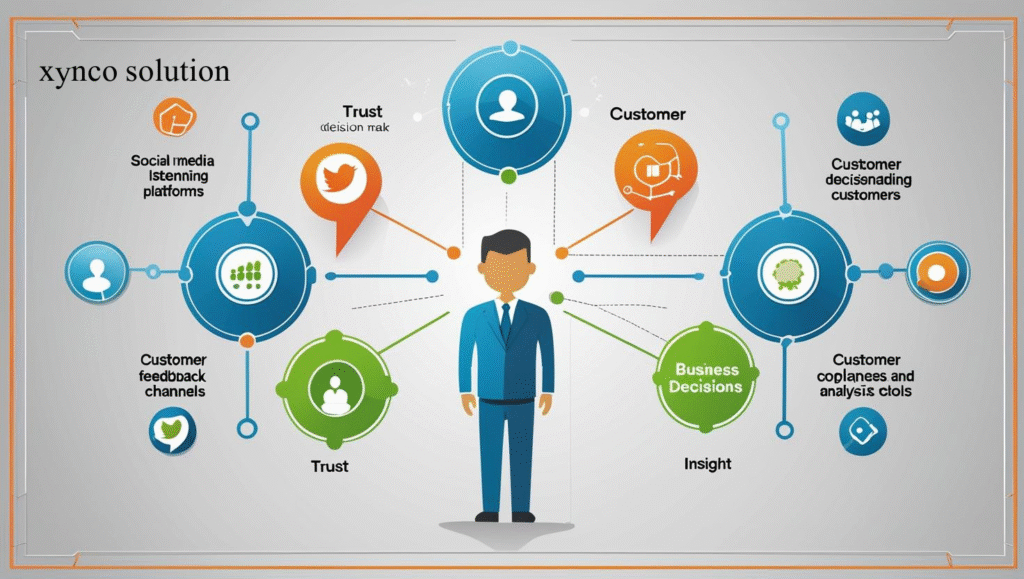
By actively listening, you gain real-time insights that can inform product development, content themes, customer service responses, and promotional timing. For example, if your audience is constantly asking for a specific feature or product variant, you can create content or offers around that exact need.
In 2025, small businesses that master social listening will be better positioned to adapt, personalize experiences, and deliver exactly what their customers are looking for—before they even ask.
How to Turn Followers into Customers (The Missing Link)
Many small businesses struggle to convert social media followers into paying customers. The key lies in building trust, showcasing value, and offering clear pathways to purchase. In 2025, this involves strategic posting, strong CTAs, lead magnets, DMs, and seamless website experiences.
Every follower is a potential customer, but they need nurturing. Educational content establishes expertise. Testimonials create trust. Limited-time offers create urgency. Strong CTAs guide users to the next step—whether it’s visiting your site, booking a service, or DMing for a quote.
You should also optimize your bio links using tools like Linktree or Taplink, ensuring users can easily access products, booking pages, or contact forms. Track clicks using UTM codes or platform analytics to see what’s converting.
Remember: your goal isn’t just to grow a following—it’s to grow a business. And every post should move a follower one step closer to becoming a customer.
Final Thoughts: Why Now is the Best Time for Small Businesses to Embrace Social Media Marketing
Social media has fundamentally changed the way small businesses grow, connect, and scale. In 2025, its power has only multiplied—with advanced tools, AI integration, visual content, and hyper-local targeting making it easier than ever for even the smallest brands to compete globally.
Whether you’re just starting out or looking to expand, the benefits are undeniable: increased visibility, real-time communication, affordable promotion, and powerful brand building. Social media is no longer just a channel—it’s the heartbeat of modern business marketing.
If your business hasn’t embraced social media yet, now is the time. The platforms are ready. The tools are accessible. And your audience? They’re already waiting for you.
Frequently Asked Questions (FAQs)
1. What is social media marketing for small businesses?
Social media marketing for small businesses refers to the use of platforms like Facebook, Instagram, TikTok, LinkedIn, and others to promote products or services, build brand awareness, engage customers, and drive sales—often with low-cost or even free strategies.
2. How can social media help a small business grow faster?
Social media helps small businesses grow by increasing visibility, building trust with potential customers, allowing direct interaction, promoting word-of-mouth, and creating opportunities for both organic and paid lead generation.
3. What are the best platforms for small business marketing in 2025?
In 2025, the most effective platforms for small businesses are Instagram, TikTok, Facebook, LinkedIn, and YouTube Shorts, depending on your audience and industry.
4. Is social media marketing cost-effective for small businesses?
Yes, it’s one of the most affordable marketing channels available. You can start with zero budget (organic content) and scale up using cost-efficient paid ads like Facebook or Instagram Ads.
5. How often should a small business post on social media?
Ideally, 3 to 5 posts per week is recommended for consistency. Quality matters more than quantity, but regular posting improves visibility and keeps the audience engaged.
6. What kind of content should small businesses post?
Post a mix of educational content, product highlights, customer reviews, behind-the-scenes content, success stories, and value-driven content tailored to your audience’s interests.
7. How do I turn social media followers into customers?
By building trust through authentic content, engagement, reviews, and strong CTAs, and by guiding users through a well-structured funnel using tools like DMs, landing pages, and offers.
8. Is it better to focus on organic content or paid ads?
Both matter. Organic content builds trust and brand loyalty, while paid ads help you reach new audiences quickly. Combining both delivers the best results.
9. How do I know if my social media marketing is working?
Use analytics tools like Meta Business Suite, Instagram Insights, or TikTok Analytics to track reach, engagement, website clicks, conversions, and follower growth over time.
10. What are social media content calendars and why are they important?
A content calendar helps plan and schedule posts in advance. It ensures consistent messaging, aligns with campaigns, and saves time—leading to better growth and performance.
11. Should I hire a social media manager or do it myself?
If you have the time and understanding, DIY is possible. But for scaling, hiring a social media manager or agency ensures consistent quality, growth strategies, and saves you time.
12. What are some common social media mistakes small businesses make?
Top mistakes include inconsistent posting, ignoring analytics, being too salesy, not engaging with followers, and neglecting storytelling or video content.
13. How long does it take to see results from social media?
It varies, but most small businesses start seeing growth in 1–3 months with consistent effort. Paid ads can generate faster results, but organic trust-building takes time.
14. How can I go viral on platforms like TikTok or Instagram?
Focus on short-form videos (Reels/TikToks), trending sounds, relatable content, clear hooks, and consistent branding. Engagement is key to triggering the algorithm.
15. What is social proof and how do I use it on social media?
Social proof includes reviews, testimonials, shoutouts, and user-generated content. Sharing this builds credibility and trust, which leads to higher conversion rates.
16. How do I create a social media marketing funnel?
A social media funnel involves attracting attention, collecting leads via offers or landing pages, nurturing through content or DMs, and converting through targeted CTAs.
17. What tools should I use for managing social media?
Top tools include Canva, Buffer, Hootsuite, Later, CapCut, Copy.ai, and Google Trends—all designed to help you create, schedule, and analyze content efficiently.
18. Can social media marketing help with local SEO?
Yes. Platforms like Facebook and Instagram allow location tagging and geo-targeted ads, which improve your visibility in local searches and increase foot traffic or local leads.
19. What’s the role of hashtags in social media growth?
Hashtags improve discoverability. Use a mix of trending, niche-specific, and local hashtags to appear in more feeds and connect with your target audience faster.
20. What’s the future of social media marketing for small businesses?
The future lies in AI integration, video-first content, personalized messaging, micro-influencers, and authenticity-driven strategies. Staying agile and adapting to trends will be crucial in 2025 and beyond.
